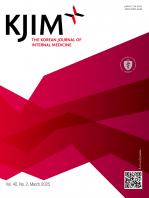|
Cardiology / Review
Updated risk assessments for sudden cardiac death in hypertrophic cardiomyopathy patients with implantable cardioverter-defibrillator
Yae Min Park
Korean J Intern Med. 2023;38(1):7-15. Published online November 10, 2022
Hypertrophic cardiomyopathy (HCM) is a genetic disease associated with a risk of malignant ventricular tachyarrhythmias and sudden cardiac death (SCD). Assessment of the SCD risk is crucial for its clinical management, and there has been considerable interest in developing risk stratification strate..
|
|
|
Cardiology / Review
Practical management of peripartum cardiomyopathy
Mi-Jeong Kim, Mi-Seung Shin
Korean J Intern Med. 2017;32(3):393-403. Published online April 14, 2017
Peripartum cardiomyopathy (PPCM) is an idiopathic cardiomyopathy that causes systolic heart failure (HF) in previously healthy young women. Despite latest remarkable achievement, unifying pathophysiologic mechanism is not well established. Considering close temporal relationship to pregnancy, the re..
|
|
|
Letter to the editor
A novel c.563 T>G, p.L189R lamin A/C mutation in identical twins with dilated cardiomyopathy
Euijae Lee, Kyung-Taek Park, Jinwoo Kang, Hyunkyung Park, Jin Joo Park, Il-Young Oh, Yeonyee E. Yoon
Korean J Intern Med. 2017;32(1):178-181. Published online March 8, 2016
|
|
|
Cardiology / Original Article
Clinical significance of changes in the corrected QT interval in stress-induced cardiomyopathy
Jung-Hee Lee, Jae-Sun Uhm, Dong Geum Shin, Boyoung Joung, Hui-Nam Pak, Young-Guk Ko, Geu-Ru Hong, Moon-Hyoung Lee
Korean J Intern Med. 2016;31(3):507-516. Published online April 7, 2016
Background/Aims: Although transient changes in the electrocardiogram (ECG) of patients with stress-induced cardiomyopathy (SCMP) are common, there are little data about ECG changes in patients with SCMP and the clinical implications of these variations.
Methods: We investigated a total of 128 pati..
|
|
|
Case Report
Reversible dilated cardiomyopathy caused by idiopathic hypoparathyroidism
Youn Joo Jung, Sung Eun Kim, Ji Yeon Hong, Jun Hee Lee, Dae Gyun Park, Kyoo Rok Han, Dong Jin Oh
Korean J Intern Med. 2013;28(5):605-608. Published online August 14, 2013
Dilated cardiomyopathy (DCM) is usually an idiopathic disease with a poor prognosis. Hypocalcemia is a rare and reversible cause of DCM. Here, we report a 50-year-old female with DCM, induced by idiopathic hypoparathyroidism, that improved after treatment with calcium.
|
|
|
Case Report
Synephrine-containing dietary supplement precipitating apical ballooning syndrome in a young female
Hyemoon Chung, Sung Woo Kwon, Tae Hoon Kim, Ji Hyun Yoon, Dae Won Ma, Yoo Mi Park, Bum-Kee Hong
Korean J Intern Med. 2013;28(3):356-360. Published online May 1, 2013
Apical ballooning syndrome (ABS) is a unique reversible cardiomyopathy that is frequently precipitated by emotional or physical stress. In addition, the few drugs reported to precipitate ABS were either illegal or strictly controlled for medical use. This paper reports a case of ABS precipitated ..
|
|
|
Letter to the editor
Stress-Induced Cardiomyopathy Presenting as Ventricular Tachycardia
Sang Cheol Cho, Wan Kim, Chung Su Park, Sang Hyun Park, An Doc Jung, Sun Ho Hwang, Weon Kim
Korean J Intern Med. 2012;27(1):107-110. Published online February 28, 2012
|
|
|
Case Report
Takotsubo Cardiomyopathy: A Case of Persistent Apical Ballooning Complicated by an Apical Mural Thrombus
Pil Hyung Lee, Jae-Kwan Song, In Keun Park, Byung Joo Sun, Seung Geun Lee, Ji Hye Yim, Hyung Oh Choi
Korean J Intern Med. 2011;26(4):455-459. Published online November 28, 2011
Takotsubo cardiomyopathy (TTC) is an infrequent cardiac syndrome characterized by acute onset chest pain with apical ballooning on echocardiography. It is often triggered by severe emotional or physical stress, and in contrast to acute myocardial infarction (AMI), the regional wall motion abnorma..
|
|
|
Case Report
Hypertrophic Cardiomyopathy Complicated by Left Ventricular Apical Necrosis and Aneurysm in a Young Man: FDG-PET Findings
Jong-Seon Park, Ihn-Ho Cho, Dong-Gu Shin, Young-Jo Kim, Gu-Ru Hong, Bong-Sup Shim
Korean J Intern Med. 2007;22(1):28-31. Published online March 31, 2007
A 29-year old male was transferred to our hospital with an abnormal chest X-ray finding diagnosed as hypertrophic cardiomyopathy with apical necrosis and aneurysm formation. Four years after the initial hospitalization, we confirmed the aneurysm and necrosis using both integrated positron emissio..
|
|
|
Original Article
Comparison of the Clinical Features of Apical Hypertrophic Cardiomyopathy Versus Asymmetric Septal Hypertrophy in Korea
Hyun Suk Yang, Jae-Kwan Song, Jong-Min Song, Duk-Hyun Kang, Cheol Whan Lee, Myeong-Ki Hong, Jae-Joong Kim, Seong-Wook Park, Seung-Jung Park
Korean J Intern Med. 2005;20(2):111-115. Published online June 30, 2005
BackgroundWe sought to test whether patients with apical hypertrophic cardiomyopathy (APH) have different clinical features compared to those with typical asymmetric septal hypertrophy (ASH). MethodsAmong 32,534 patients who underwent routine ec..
|
|
|
















